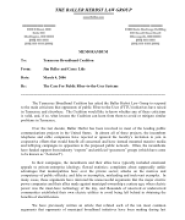
Fast, affordable Internet access for all.

The Baller Herbst Law Group filed an extensive report with the FCC detailing important information about OneCommunity - a fascinating nonprofit organization connecting many communities with fiber and wireless connectivity in Ohio. OneCommunity works with a variety of public and private sector partners to expand access to last mile and middle mile connectivity. Because they fall within our broad definition of putting public needs first, I wanted to highlight this report.
OneCommunity’s roots go back to 2001. At the time, Case Western Reserve University (Case) had a robust fiber-optic communications system and considerable networking expertise, but the rest of Cleveland lacked advanced communications capability. Case’s president, Edward Hundert, and its chief information officer, Lev Gonick, believed that broadband connections to the Internet promised to be a major factor in the local economy’s long-term health; that broadband could transform Northern Ohio from a manufacturing-based to an information-based economy; and that Case could play a profoundly beneficial role in enhancing Cleveland’s broadband future. As a result, Hundert and Gonick reached out to several of Cleveland’s leading government, educational, cultural, philanthropic, and other non-profit organizations and persuaded them to join Case in founding a new entity called “OneCleveland” that would provide gigabit connectivity to participating organizations and pave the way for widespread and free wireless service.
OneCleveland expanded far outside the City and changed its name to OneCommunity. It has already tallied an impressive list of achievements:
In the Northern Ohio region, OneCommunity facilitated public and private arrangements for the deployment of a gigabit-capacity fiber-optic community network, soon spanning 22 counties and now serving over 200 subscriber entities and 1,500 schools, hospitals, clinics, government, and public safety locations. Over one million citizens are affected by the organizations that OneCommunity serves through the network.
The network is open and carrier neutral, but so much more. Read the paper -- and appendixes -- for more information. PS : I should note that I disagree with the conclusion:

The Tennessee Broadband Coalition has asked the Baller Herbst Law Group to respond to the main criticisms that opponents of public Fiber-to-the-User (FTTU) initiatives have raised in Tennessee and elsewhere. The Coalition would like to know whether any of these criticisms is valid, and, if so, what lessons the Coalition can learn from them to avoid or mitigate similar problems in Tennessee. Over the last decade, Baller Herbst has been involved in most of the leading public communications projects in the United States. In almost all of these projects, the incumbent telephone and cable companies have rejected or ignored the locality’s invitation to join in cooperative efforts that would benefit all concerned and have instead mounted massive media and lobbying campaigns in opposition to the proposed public network. Often, the incumbents have funded support from industry “experts” and artificial “grassroots” groups (which have come to be known as “Astroturf”). In their campaigns, the incumbents and their allies have typically included emotional appeals to private-enterprise ideology; flawed statistics; complaints about supposedly unfair advantages that municipalities have over the private sector; attacks on the motives and competency of public officials; and false or incomplete, misleading and irrelevant examples. In many cases, these arguments have mirrored the unsuccessful arguments that the major electric power companies and their allies made against municipal ownership a century ago, when electric power was the must-have technology of the day, and thousands of unserved or underserved communities established their own electric utilities to avoid being left behind in obtaining the benefits of electrification.
